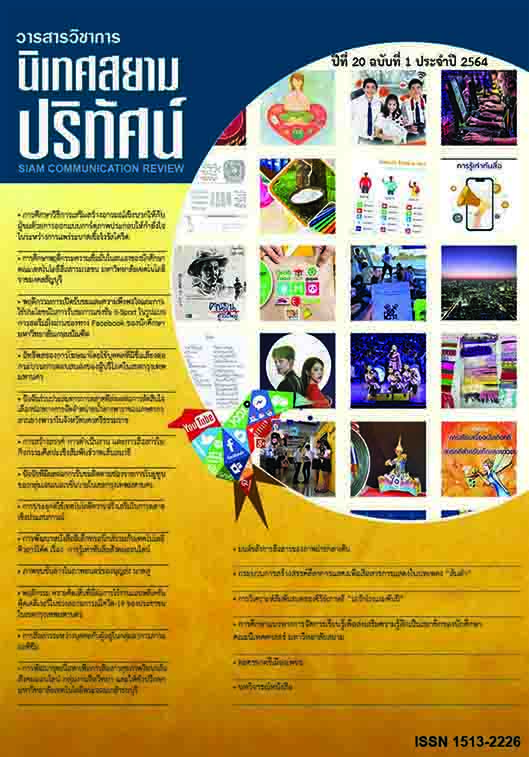The Representation of the Lower Class in the Film of Boonsong Nakphoo
Main Article Content
Abstract
The qualitative research “The Representation of the Lower Class in the Films of Boonsong Nakphoo” aims to study the representation of lower class in Boonsong Nakphoo’s films and the director’s perspectives on the representation of the lower class. The research employed textual analysis method to analyze Boonsong’s six films together with in-depth interviewing the film director.
The research found that the characteristic of lower class presented in Boonsong Nakphoo’s films are represented by the rough life of the characters. Storylines are created based on poverty and family relationship problems. Main characters that come from lower class seem to be slow response as they wait until the problems become worse before start resolving. The films also demonstrate selfishness of many characters that finally end up with concession and adaptation to reality and social system. The director’s thought reflects in the films’ resolution and ending as the main characters survives and either keeps their individuality or choose to conform to their society.
The construction of Boonsong Nakphoo’s lower class identity via cinema languages is to let the middle-class audiences openly think and understand what he wants to communicate. The cinema languages employed in the films include Long Take technique for composition, natural sound used, and slow rhythm editing technique to allow the spectators slowly immerse into the film content and think until realization.
The research also demonstrated that Boonsong considers the lower-class people as victims of the social structure. These people do not have many choices or power to bargain and to solve any problem. They are in an inescapable situation.
Article Details
References
กาญจนา แก้วเทพ. (2541) สื่อสารมวลชน ทฤษฎีและแนวทางการศึกษา. กรุงเทพฯ: โรงพิมพ์ภาพพิมพ์.
กำจร หลุยยะพงศ์. (2556) ภาพยนตร์กับการประกอบสร้างสังคม ผู้คน ประวัติศาสตร์ และชาติ. กรุงเทพฯ: จุฬาลงกรณ์มหาวิทยาลัย.
ประวิทย์ แต่งอักษร. (2551). มาทำหนังกันเถอะ ฉบับตัดต่อใหม่ (พิมพ์ครั้งที่ 4). กรุงเทพฯ: ไบโอสโคป พลัส.
ปิยะกุล เลาวัณย์ศิริ. (2529). การวางมุมกล้อง. กรุงเทพฯ: บพิธการพิมพ์.
รักศานต์ วิวัฒน์สินอุดม. (2547). เสกฝัน ปั้นหนัง : บทภาพยนตร์. กรุงเทพ: บ้านฟ้า.
อรรถจักร์ สัตยานุรักษ์. (2542). จากคนนอกสู่คนชายขอบ. ศิลปวัฒนธรรม. (20)12, 69-76.
อัญมณี ภักดีมวลชน. (2552). การสื่อสารภาพตัวแทนของคุกชายในภาพยนตร์ไทย: ศึกษากรณี ภาพยนตร์เรื่อง “น.ช.นักโทษชาย”. วิทยานิพนธ์ปริญญามหาบัณฑิต สาขาสื่อสารมวลชน คณะวารสารศาสตร์และสื่อสารมวลชน, มหาวิทยาลัยธรรมศาสตร์.
ระบบออนไลน์
ใจ อึ๊งภากรณ์. (2561, 2 ธันวาคม). พรรคของชนชั้นกรรมาชีพ. [เว็บบล็อก]. เข้าถึงได้จาก https://turnleftthai.wordpress.com/2018/12/02/พรรคของชนชั้นกรรมาชีพ
ณัฎฐ์ธร กังวาลไกล และอัญชลี ไชยวราพร. (2553, 10 มิถุนายน). คนจนผู้ยิ่งใหญ่ ตัวตนที่แท้จริงของบุญส่ง นาคภู่.[เว็บบล็อก]. เข้าถึงได้จาก http://www.thaicinema.org/interview17_sueb.php
บุญรักษ์ บุญญะเขตมาลา. (2547, 23 ธันวาคม). “สุดเสน่หา” ตอม่อของภาพยนตร์ใต้ดินไทย. ผู้จัดการออนไลน์: เข้าถึงได้จาก https://mgronline.com/daily/detail/9470000101200
วิวัฒน์ เลิศวิวัฒน์วงศา. (2561, 15 ตุลาคม). จาก คนจนผู้ยิ่งใหญ่ ถึง เณรกระโดดกำแพง: จักรวาลสามัญชน ของ บุญส่ง นาคภู่. The Momentum. เข้าถึงได้จากhttps://themomentum.co/boonsong-nakpu-film-2018


